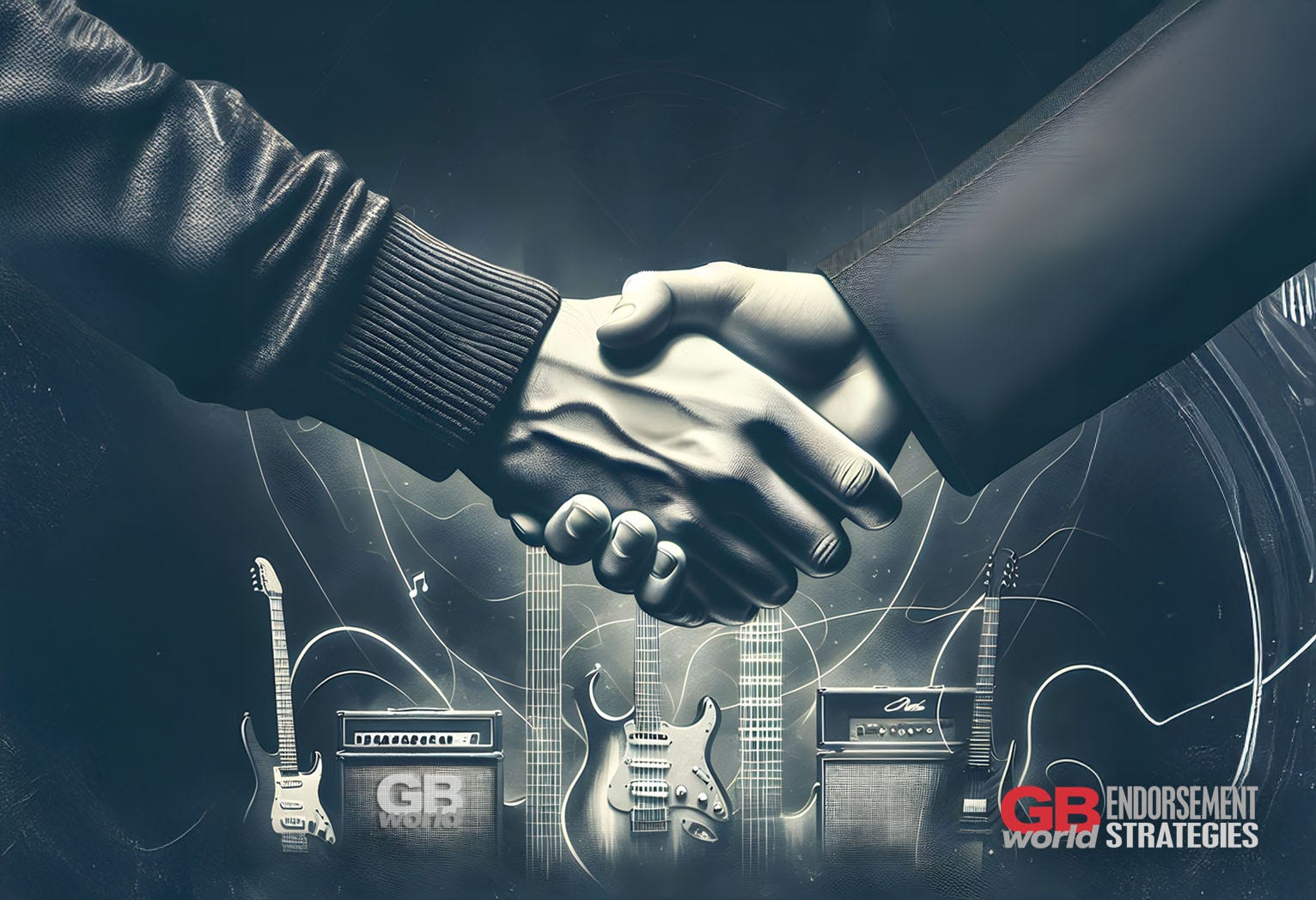The Endorsement Equation: Do Artist Deals Still Deliver?
A look at where artist endorsements came from, what they mean today, and how both sides can make them work.
First in a series. Subscribe to get more!
In the world of guitar-related business, few things carry the same mystique—or confusion—as the artist endorsement. Ask five people what an endorsement is, and you’ll get five different answers, especially in the guitar world. To some, it’s a free gear deal. To others, it’s a badge of honor. For companies, it’s often a marketing tool—but one that may or may not deliver actual results.
Endorsements have become so common that their meaning is often diluted. But they’re not dead. In fact, if you’re in this business—on either side of the relationship—they might be more important than ever. The key is understanding what they really are, what they’re not, and how they need to evolve to stay relevant.
To do that, we need to go back—because the concept of the artist endorsement wasn’t born on Instagram.
The Early Days of Endorsement: Building Brands with Artists
Artist endorsements have been part of the guitar business since its earliest golden age. In the 1950s and ’60s, companies like Fender and Gibson didn’t just build guitars—they built reputations through association.
Leo Fender was known for putting instruments into the hands of working musicians. Not necessarily the biggest stars at the time, but players who were visible—performing, recording, and influencing the scene. The idea was simple: if musicians saw other musicians using the gear, credibility followed. And credibility led to sales.
Meanwhile, Gibson leaned harder into the celebrity factor. High-profile players like Les Paul, Chuck Berry, and later Jimmy Page and others weren’t just users of Gibson guitars—they were the faces of them. Full-page magazine ads, artist rosters, and product lines tied to recognizable names created a sense of prestige and aspiration. Owning a Gibson wasn’t just about tone—it was about status.
Back then, an endorsement deal often included exclusivity, promotional appearances, even custom models. There was mutual investment—both financial and reputational—and it worked because the visibility artists brought translated directly into influence and market share.
But that was then. And we’re not living in that world anymore.
The Landscape Today: Visibility Without Value?
Fast forward to now—and the endorsement landscape has changed beyond recognition.
We’re in an era where almost anyone can present themselves as an “endorsed artist.” All it takes is a logo in the Instagram bio and a tag on a post. But the question is: Does it mean anything?
The old-school endorsement model was built on visibility—TV, radio, print, tours. Now, visibility is fragmented. Everyone has a platform, but not everyone has a real audience. The reach once reserved for a select few has been democratized—but so has the noise.
For companies, this creates a serious challenge. The line between promotion and performance is blurred. A player might have a strong social media following, but if those followers aren’t relevant or engaged, the endorsement brings little return. Likewise, some incredibly talented players with niche but dedicated followings can be overlooked because they don’t “look the part” online.
Meanwhile, artists often misunderstand what companies are looking for. The assumption is that playing well and having a few followers equals a free guitar or whatever. But in a market driven by tighter margins and accountability, that's not how it works anymore.
Endorsements today are often reduced to soft deals—discounts, one-time features, tag-and-post exchanges. There’s nothing wrong with that, if both sides understand the value being exchanged. But more often than not, there’s a disconnect.
The Disconnect: Expectation vs. Reality
Here’s where it gets sticky.
Artists may believe an endorsement means validation, exposure, or access. They expect gear, features, and maybe even long-term relationships.
Companies, on the other hand, are looking for return on investment—tangible outcomes like increased visibility, engagement, and ultimately, sales.
That gap between expectation and reality creates friction. An artist might think, “They’re giving me a discount—that’s nothing!” Meanwhile, the company is thinking, “We gave you visibility—where’s the return?”
And so both sides walk away underwhelmed, confused, or disappointed.
Rethinking the Relationship
What if we reframed the endorsement not as a reward or a favor, but as a partnership?
At its best, an endorsement is a mutual agreement to help each other grow. The company gets authentic visibility through an artist who aligns with their brand. The artist gains access to tools and exposure that help them advance their career.
Here’s where it gets interesting: It’s not always about the biggest name.
The micro-endorsement model—supporting niche artists with dedicated audiences—can offer better engagement and longer shelf life than a single post from a high-profile artist.
Some companies are starting to recognize this, building tiered or flexible programs that prioritize community over clout. Likewise, some artists are learning that the most effective partnerships are the ones where they’re active participants, not just recipients.
Opening the Door: What’s Next
This article is just the start. In the coming pieces, we’ll dive deeper into this dynamic:
What makes an artist endorseable today?
What should companies be looking for in a potential endorser?
How do you measure the real value of a partnership?
And how can both sides create win-win relationships that go beyond the surface?
Final Thought (for now)
The endorsement isn’t dead. It just needs to grow up.
If artists and companies treat these partnerships as real business relationships—with mutual value, clarity, and intent—there’s still a ton of potential. But the days of “free gear for a shoutout” are fading. What comes next is up to all of us.





